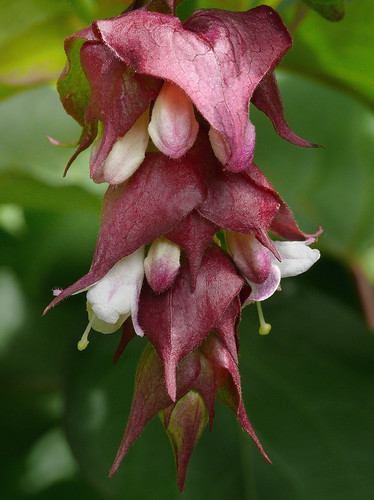are blackberries self pollinating? Or do they need insects to pollinate them?
inflorescence best answer:
Answer by Elizabeth H
Self-pollinating, except for Cascade Trailing.
inflorescence
Leycesteria formosa #3

Best viewed @ large size
Caprifoliaceae - Himalayas and southwestern China
Himalayan Honeysuckle, Flowering Nutmeg, Himalayan Nutmeg, Pheasant Berry
Shown: Inflorescence displaying buds and opened flowers
"Leycesteria is a genus of flowering plants in the honeysuckle family Caprifoliaceae, native to temperate Asia in the Himalaya and southwestern China.
"It contains six or seven species of shrubs with short-lived stems with soft wood, growing to 1-2.5 m tall. One species, Leycesteria formosa (Himalayan Honeysuckle or Flowering Nutmeg), is a popular garden shrub in Britain.
"Leycesteria formosa (Himalayan Honeysuckle, Flowering Nutmeg, Himalaya Nutmeg or Pheasant Berry) is a deciduous shrub in the family Caprifoliaceae, native to the Himalaya and southwestern China.
"Leycesteria formosa...has soft, hollow, upright green stems 1-2 m tall, which only last for 2-5 years before collapsing and being replaced by new stems from the roots. The leaves are opposite, dark green, 6-18 cm long and 4-9 cm broad, with an entire or wavy margin. The flowers are produced on 5-10 cm long pendulous racemes; each flower is small, white, subtended by a purple bract. The fruit is a soft purple-black berry 1 cm diameter, eaten by birds which disperse the seeds." (Wikipedia)
Additional views:
farm4.static.flickr.com/3074/3851425175_7c753a6349_b.jpg
farm4.static.flickr.com/3028/3851429593_76b0467b45_b.jpg
farm3.static.flickr.com/2262/3851437799_b2e8f6791d_b.jpg
farm3.static.flickr.com/2481/3851443581_14dd8773f2_b.jpg
Photographed in San Francisco Botanical Garden - San Francisco, California
Orignal From: are blackberries self pollinating? Or do they need insects to pollinate them? and Leycesteria formosa #3
No comments:
Post a Comment